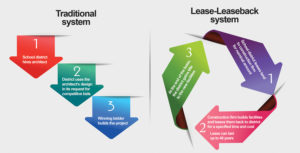By Tyree K. Dorward, Attorney for Best Best & Krieger LLP
 As most school districts are now aware, recently enacted Assembly Bill 2316 (“AB 2316”) went into effect on January 1, 2017 and makes substantial changes to the lease-leaseback procurement method (“LLB”) for K-12 school construction.
As most school districts are now aware, recently enacted Assembly Bill 2316 (“AB 2316”) went into effect on January 1, 2017 and makes substantial changes to the lease-leaseback procurement method (“LLB”) for K-12 school construction.
Prior to the adoption of AB 2316, Education Code Section 17406 authorized school districts, without advertising for bids, to lease property to a contractor under a LLB agreement. Typically, under such agreements the contractor constructs the school facilities and then leases the facilities back to the school district, with title vesting in the school district at the end of the lease. However, in the absence of any required competitive selection process under the previous provisions of the Education Code, the LLB delivery method had been subject to several challenges which created uncertainty regarding school districts ability to utilize the delivery method for future projects.
As a response to the ongoing legal challenges and uncertainty, AB 2316 was introduced, and supported by the building industry and statewide school district groups such as CASH, CASBO, and CSBA, ultimately passed and signed by the Governor into law in order to address the issues raised by past legal challenges. While many of the requirements AB 2316 were actually already in use by the majority of school districts as “best practices” in the past, these best practices are now codified into the new requirements of Education Code section 17400 et seq. These provisions now provide a clear, statutorily authorized process and set of procedures for the lawful use of the LLB delivery method.
Specifically, AB 2316 establishes a new required competitive “best value” request for proposal (“RFP”) procurement process for LLB projects which is modeled after the existing selection process for design-build construction projects. School districts utilizing the LLB delivery method will now need to adopt and publish required procedures and guidelines for evaluating the qualifications of proposers that ensure the best value selections are conducted in a fair and impartial manner. The successful proposer must be selected based on evaluation criteria set forth in the RFP, including price and qualifications.
The required procedures must include, at a minimum, the following:
- The school district must prepare a RFP which includes an estimate of the project price, a precise description of any preconstruction services that may be required and of the facilities to be constructed, the key elements of the instrument to be awarded, a description of the format that proposals must follow and the elements they shall contain, the standards that will be used in evaluating proposals, the date on which proposals are due, and the timetable the school district will follow in reviewing and evaluating proposals.
- School districts must give notice of the RFP in the manner of notice provided in Public Contract Code Section 20112, with the latest notice published at least 10 days before the date for receipt of the proposals.
- A proposer must be prequalified in accordance with Public Contract Code Section 20111.6, subdivisions (b) to (m) in order to submit a proposal, and, if used, electrical, mechanical, and plumbing subcontractors are subject to the same prequalification requirements.
- The RFP must identify all criteria that will be considered in the proposal evaluation, including factors such as relevant experience, safety record, and price proposal. The price proposal shall include, at the school district’s discretion, either a lump-sum price or a proposed fee to perform the services requested. The RFP must specify whether each criterion will be evaluated pass-fail or will be scored as part of the best value score, and whether proposers must achieve any minimum qualification score.
- For each scored criterion, the methodology and rating or weighting system that will be used by the school district in evaluating the criterion, including the weight assigned to the criterion and any minimum acceptable score, must be identified.
- Once a best value score is assigned to each proposal based on the criteria and evaluation methodology established in the RFP, the school district must rank all responsive proposals from the highest best value to the lowest best value. The award of a contract must be made by the school district’s governing board to the responsive proposer whose proposal is determined, in writing, to be the best value to the school district.
AB 2316 also expressly authorizes school districts to enter into a contract with the LLB contractor for preconstruction services, including advice given during the design phase about matters such as value engineering, constructability review, scheduling, pricing, and phasing to assist the school district in designing a more constructible project. School districts may do this prior to obtaining written approval from the Division of the State Architect (DSA) so long as the contract provides that no work for which a contractor is required to be licensed and for which DSA approval is required can be performed before receipt of the required DSA approval.
So long as a school district solicits, awards, and enters into a LLB agreement in accordance with these AB 2316 requirements, we believe such an agreement will be legally defensible. In other words, AB 2316 now provides a “safe harbor” for future use of the LLB delivery method.

